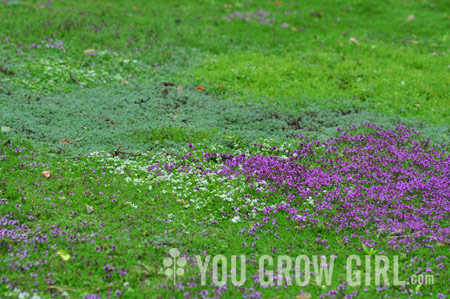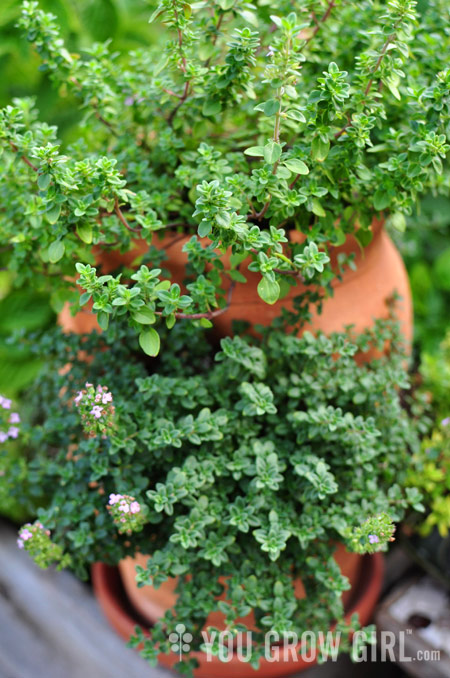
I’m way behind on posting past articles from my Globe & Mail column. This profile of thyme was published on July 19, 2010. I thought I’d go with it first since the article set to be published this coming Saturday is a profile of another favourite garden herb: sage.
—————–
Most of the country, including Toronto, has just now survived a heat wave. It was hot, especially out on the roof garden, my little piece of heaven turned to hell by the scorching sun. It was only inhabitable after dark – we spent the week offering emergency critical plant care by flashlight.
In that heat, some containers required watering three times per day! The lettuces, violas (miraculously still alive), and even typically resilient basil and tomatoes growing in larger pots put up a fuss of dramatic fainting, fretting, and impromptu wilting when the heat was at its worst. My once lush and healthy lemon tree mysteriously dropped all of its leaves on one side. But trusty, tough-as-nails thyme never once complained. I simply shifted a few pots into slightly less intense sun and it was business as usual.
For a tiny plant, thyme has got it all – looks, an easy going nature, a deliciously warm aroma, a pungent, complicated flavour, and it makes an impact in a cramped space. It is one of only a few edibles that can survive a full growing season in the 4” transplant pot it came home in. In fact, thyme will grow just about anywhere and in anything. In the wild, thyme grows among rocks in very free-draining and poor, often sandy soil.

It’s a very hardy plant that can survive a cold zone 4 winter, as long as the soil is not dense or soggy. I inexplicably lost several plants in my community garden’s premium soil, until I finally hit on the key – thyme simply will not tolerant life in wet soil through a wet winter. This plant doesn’t do nutrient rich, gorgeous soil well. To keep it alive, add lots of rock, sand or grit to increase your soil drainage in-ground. I recently visited a garden filled with happy thyme, all grown directly on top of driveway gravel!
Soil drainage is generally easier to achieve in pots. Most thyme varieties will adapt to pots too small or difficult for anything but cacti and succulents as long as there are lots of holes for water to flow straight out. Potted plants won’t survive outside year-round throughout most parts of Canada but a little pot in a sunny window can provide some fresh greenery here and there until it is warm enough to go back out in the early spring. Otherwise it is new transplants each year. Don’t bother growing from seed unless you intend to grow a lot of any one variety.
Speaking of variety, thyme is an incredibly versatile herb and far beyond the woody and pungent common type (Thymus vulgaris) available at most grocery stores. I’ve got about 12 varieties in a surprising breadth of flavours, smells, colours, and growth forms growing on my roof right now, yet my collection if far from complete.
Next to the common English thyme, deliciously fragrant lemon and lime citrus types (Thymus x citrodorus) are probably most popular and widely available in garden shops and corner markets. There are several varieties that qualify in this category – they come in shades of green, gold, variegated gold ‘Aureus’, and variegated silver ‘Silver Lemon Queen’. ‘Doone Valley’ is very low growing, with round, green leaves spattered with pale gold and cream. ‘Orange Balsam’ and ‘Orange Spice’ have a sweet and spicy orange peel smell and pointy leaves that strike me as a bit conifer-like.
Next up are the creepers: Mother-of-thyme (Thymus serphyllum), Thymus ‘Coccineus’, and woolly thyme (Thymus psuedolanuginosus). They aren’t particularly edible, but they make an aromatic, drought tolerant lawn alternative that you can actually walk on. There are also very diminutive types that form a soft, plush carpet over and between cracks in cement and stone walls. If you’re going to go this route, be sure to grow several varieties together so that you have different textures, smells, and flower colours in bloom together and at varying intervals.
The most compelling are the mimics; thyme plants that smell convincingly like other herbs. I’m currently growing ‘Lavender’, ‘Nutmeg’, ‘Oregano’, ‘Caraway’ (Thymus herba-barona), and ‘Rose Petal’. While I am still finding culinary uses for some of the more unusual flavours, I’ve found that all types seem to pair well with onions. Roast a couple of summer onions in the oven along with thyme leaves and stems, and a splash of olive oil. Don’t forget to dry a few sprigs at the season’s end so you can enjoy this warming dish through the winter.
Thyme is one of my absolute favorites! I grow an obscene amount of thyme each year and I somehow manage to always use all of it. I usually end up drying most of it to use throughout the winter – last year I ended up with a huge jar full, but it was all gone by about March.
I usually just plant a bunch in pots, but I put a small plant into my perennial bed this spring and I’m going to try overwintering it – I’m in Zone 3 so I’m trying to be optimistic about it!
I love thyme! I have a few small pots, but my favorite is lemon. It’s dreamy & it goes in all my pasta dishes. Especially, of coures, lemon alfredo sauce.
(Your photos are beautiful. Very happy thyme.)
dahlila
@Megan,
I have a glorious carpet of several varieties of thyme cascading and creeping alongside the makeshift stairs to my cottage. The cottage is just south of Gravenhurst, with little to no soil on rock. The sun exposure varies from morning sun to full shade – not entirely ideal. All the varieties have flourished, with wooly carpet thyme, creeping lemon carpet, creeping thyme, mother of thyme, wild thyme, etc… all intermingling together. They were planted to stabilize the ‘soil’ around the stairs we cut/built out of the side of the rock/tree root path from the lake to the cottage.
I chose several varieties to experiment with colour, texture and succes rate. After two summers with zero pampering, (and some trampling from dogs, toddlers, teenagers and drunken sots, plus other beasties like deer, bears, etc when we aren’t there – not to mention skidoos in the winter) the creeping thyme has more than octupled (is that a word) its original 2″ pot size. The rest are slightly more sedate (minus thyme may appear a dainty lady, but she holds her own with the wooly carpet) but no less vigorous. So do not be discouraged by your possible zone limitations. There are varieties out there that are rated to Zone 3. Try Richter’s Herbs in Goodwood.
The trek up the 30 plus stairs, carrying any combination of 6 month old, 2 year old, 4 year old, giant jugs of water, and other paraphenalia for the weekend is made more enjoyable when something or somebody brushes up against the tiny leaves, releasing a spicy fragrance into the fresh Muskoka air.
You have given me a new-found respect for thyme. I really must make an effort to do more in the kitchen with the one I have. I think I’m in zone 5b and I’m just wondering what to do with mine when winter comes. Perhaps it would be safest to bring it inside. What do you think?
Allison: You can overwinter it outdoors in zone 5b. Good soil drainage is the key. That said, it’s pretty forgiving in a pot, too.
Thanks so much for this wonderful (as usual) post, Gayla.
It’s inspired me to add more varieties of thyme to my balcony garden. I just finished repotting ‘Doone Valley’ a few minutes ago. The combination of sweet scent plus warm sunshine (after days of rain) was my Saturday morning treat. Even just 5 minutes in the garden can lift the mood & soothe the “monkey mind.” Now on to the rosemary…..